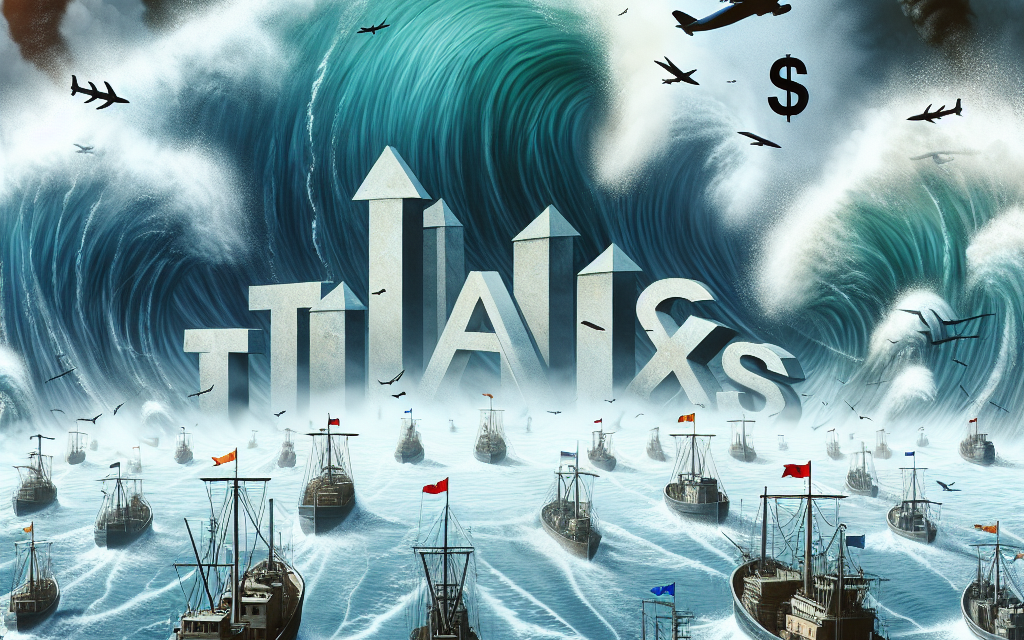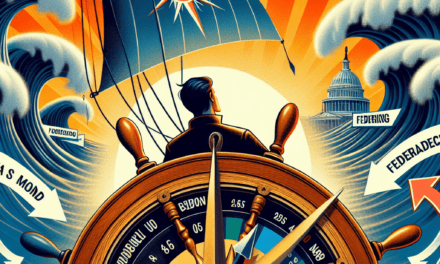“Unpacking the Impact: Navigating the Risks of Trump’s Tariffs on The Market’s Strain.”
Introduction
The Market’s Strain: Navigating the Risks of Trump’s Tariffs explores the complex landscape of international trade and economic policy during the Trump administration. As tariffs were implemented on various goods, businesses and consumers faced significant challenges and uncertainties. This introduction delves into the implications of these tariffs on domestic industries, global supply chains, and consumer prices, highlighting the strategic decisions companies had to make in response to shifting trade dynamics. By examining the broader economic impact and the reactions from both domestic and international markets, this analysis aims to provide a comprehensive understanding of the risks and opportunities presented by Trump’s tariff policies.
Understanding Trump’s Tariffs: An Overview
The implementation of tariffs under the Trump administration marked a significant shift in U.S. trade policy, aiming to protect domestic industries while addressing perceived imbalances in international trade. Understanding these tariffs requires a comprehensive examination of their origins, objectives, and implications for both the U.S. economy and global markets. Initially, the rationale behind these tariffs was rooted in the belief that foreign competitors were benefiting from unfair practices, such as currency manipulation and subsidies, which undermined American manufacturing. Consequently, the administration sought to impose tariffs on a range of goods, particularly targeting imports from China, which was viewed as a primary adversary in this economic landscape.
As the tariffs were introduced, they were framed as a means to bolster American jobs and revive industries that had suffered due to globalization. The administration argued that by making imported goods more expensive, consumers would be encouraged to purchase domestically produced items, thereby stimulating local economies. However, this perspective oversimplified the complexities of global supply chains and the interconnectedness of modern economies. For instance, many U.S. companies rely on imported materials and components to manufacture their products. As tariffs increased the cost of these imports, businesses faced higher production costs, which often translated into increased prices for consumers.
Moreover, the retaliatory measures taken by other countries in response to U.S. tariffs further complicated the situation. Nations affected by these tariffs, particularly China, implemented their own tariffs on American goods, targeting key sectors such as agriculture and manufacturing. This tit-for-tat escalation not only strained diplomatic relations but also created uncertainty in the market, leading to volatility that affected investors and businesses alike. The agricultural sector, in particular, felt the brunt of these retaliatory tariffs, as farmers found their products facing higher barriers in foreign markets, resulting in significant financial losses.
In addition to the immediate economic impacts, the long-term consequences of Trump’s tariffs are still unfolding. While some industries may have benefited from temporary protection, the overall effect on the economy remains contentious. Critics argue that the tariffs have led to job losses in sectors reliant on exports and have hindered economic growth by disrupting established trade relationships. Furthermore, the increased costs associated with tariffs have raised concerns about inflation, as consumers are forced to pay more for everyday goods. This inflationary pressure can erode purchasing power, ultimately affecting the broader economy.
Transitioning from the immediate effects to the broader implications, it is essential to consider how these tariffs have reshaped the global trade landscape. The U.S. has historically been a proponent of free trade, and the shift towards protectionism under Trump’s administration has prompted discussions about the future of international trade agreements. As countries reassess their trade strategies in light of U.S. policies, the potential for a more fragmented global trading system looms large. This fragmentation could lead to increased economic isolationism, which may have far-reaching consequences for global economic stability.
In conclusion, understanding Trump’s tariffs involves recognizing their multifaceted nature and the intricate web of economic relationships they influence. While the intention behind these tariffs was to protect American interests, the reality is that they have introduced a host of challenges that extend beyond national borders. As businesses and policymakers navigate this complex landscape, the need for a balanced approach to trade that considers both domestic priorities and global interdependence becomes increasingly evident. The ongoing dialogue surrounding these tariffs will undoubtedly shape the future of U.S. trade policy and its role in the global economy.
The Economic Impact of Tariffs on Small Businesses
The imposition of tariffs under the Trump administration has had a profound impact on the economic landscape, particularly for small businesses that often operate on thin margins and limited resources. As these tariffs were introduced, ostensibly to protect American industries and promote domestic production, the unintended consequences began to ripple through the economy, affecting small enterprises in various sectors. Understanding the economic impact of these tariffs is crucial for small business owners who must navigate an increasingly complex market environment.
Initially, tariffs can lead to increased costs for small businesses that rely on imported goods or raw materials. For instance, a small manufacturer that sources components from overseas may find that the additional tariffs imposed on those imports significantly raise their production costs. This increase can force small businesses to either absorb the costs, which can erode profit margins, or pass them on to consumers, potentially leading to higher prices. As a result, small businesses may struggle to remain competitive against larger firms that have more flexibility in managing their supply chains and costs.
Moreover, the uncertainty surrounding tariffs can create a challenging environment for small businesses when it comes to planning and investment. Business owners often rely on stable economic conditions to make informed decisions about expansion, hiring, and inventory management. However, the fluctuating nature of tariffs can lead to unpredictability in pricing and availability of goods, making it difficult for small businesses to forecast their financial futures. This uncertainty can stifle innovation and growth, as entrepreneurs may hesitate to invest in new projects or hire additional staff when they are unsure of the economic landscape.
In addition to direct cost implications, tariffs can also disrupt established trade relationships. Small businesses often depend on long-term partnerships with suppliers and customers, and the introduction of tariffs can strain these relationships. For example, a small retailer that has built a rapport with an overseas supplier may find that the increased costs associated with tariffs lead to a breakdown in negotiations or a shift in sourcing strategies. This disruption can not only affect the immediate financial health of the business but can also have long-lasting effects on its reputation and market position.
Furthermore, the broader economic implications of tariffs can lead to reduced consumer spending, which is particularly detrimental to small businesses. As prices rise due to increased costs from tariffs, consumers may become more cautious with their spending, opting to delay purchases or seek alternatives. This shift in consumer behavior can lead to decreased sales for small businesses, further exacerbating the challenges they face in an already competitive market. The interconnectedness of the economy means that the effects of tariffs extend beyond individual businesses, impacting entire communities and local economies.
In conclusion, the economic impact of tariffs on small businesses is multifaceted and significant. From increased costs and disrupted supply chains to uncertainty in planning and reduced consumer spending, small enterprises must navigate a landscape fraught with challenges. As they adapt to these changes, it is essential for small business owners to remain informed and agile, seeking out strategies to mitigate the risks associated with tariffs while continuing to pursue growth and sustainability in an evolving market. The ability to respond effectively to these economic pressures will ultimately determine the resilience and success of small businesses in the face of ongoing trade tensions.
Strategies for Investors Amidst Tariff Uncertainty
As the global economy grapples with the implications of tariffs imposed during the Trump administration, investors find themselves navigating a landscape fraught with uncertainty. The introduction of tariffs on various goods has not only affected trade relationships but has also created ripples across financial markets. Consequently, investors must adopt strategic approaches to mitigate risks and capitalize on potential opportunities that arise from this evolving situation.
To begin with, diversification remains a cornerstone of any robust investment strategy, particularly in times of heightened volatility. By spreading investments across different asset classes, sectors, and geographic regions, investors can reduce their exposure to any single economic event or policy change. For instance, while certain industries may suffer due to tariffs—such as manufacturing and agriculture—others, like technology and renewable energy, may thrive as they adapt to new market conditions. Therefore, a well-diversified portfolio can help cushion the impact of adverse developments while positioning investors to benefit from sectors that may experience growth.
In addition to diversification, investors should closely monitor the sectors most affected by tariffs. Understanding the nuances of how tariffs influence supply chains and pricing structures can provide valuable insights. For example, companies that rely heavily on imported materials may face increased costs, which could lead to reduced profit margins. Conversely, firms that can pass these costs onto consumers or those that source materials domestically may emerge relatively unscathed. By conducting thorough research and analysis, investors can identify which companies are likely to weather the storm and which may struggle, allowing for more informed investment decisions.
Moreover, staying informed about policy changes and economic indicators is crucial in this environment. The political landscape can shift rapidly, and tariffs may be adjusted or removed based on negotiations or changing economic conditions. Investors should keep a close eye on trade talks, government reports, and economic data releases that could signal shifts in the market. By being proactive and responsive to these developments, investors can better position themselves to react to changes that may impact their portfolios.
Another strategy involves considering alternative investments that may provide a hedge against tariff-related risks. For instance, commodities such as gold often serve as a safe haven during periods of economic uncertainty. Additionally, investing in exchange-traded funds (ETFs) that focus on sectors less sensitive to tariffs can offer a way to maintain exposure to the market while mitigating risk. These alternative investments can provide a buffer against potential losses in more vulnerable sectors.
Furthermore, investors should not overlook the potential for opportunities that arise from tariff-induced market dislocations. While some companies may struggle, others may find ways to innovate or adapt their business models in response to new challenges. Identifying these companies early can lead to significant gains as they capitalize on changing market dynamics. Therefore, maintaining a flexible investment approach that allows for quick adjustments can be beneficial in seizing these opportunities.
In conclusion, navigating the risks associated with Trump’s tariffs requires a multifaceted strategy that emphasizes diversification, sector analysis, and a keen awareness of the political and economic landscape. By remaining informed and adaptable, investors can not only protect their portfolios from potential downturns but also position themselves to take advantage of emerging opportunities in an ever-changing market. As the global economy continues to evolve, those who approach these challenges with a strategic mindset will be better equipped to thrive amidst uncertainty.
The Global Supply Chain: Adapting to Tariff Changes
The global supply chain has undergone significant transformations in recent years, particularly in response to the evolving landscape of international trade policies. One of the most impactful developments has been the imposition of tariffs by the Trump administration, which has created a ripple effect across various industries and countries. As businesses grapple with the implications of these tariffs, they are compelled to adapt their supply chain strategies to mitigate risks and maintain competitiveness in an increasingly complex market.
Initially, the tariffs were introduced as a means to protect domestic industries from foreign competition, particularly in sectors such as steel and aluminum. However, the unintended consequences of these measures have prompted companies to reassess their sourcing and production strategies. For instance, manufacturers that relied heavily on imported materials found themselves facing increased costs, which in turn threatened their profit margins. Consequently, many businesses began exploring alternative suppliers, both domestically and internationally, to circumvent the financial burden imposed by tariffs.
In this context, the concept of supply chain diversification has gained prominence. Companies are now more inclined to establish relationships with multiple suppliers across different regions, thereby reducing their dependence on any single source. This strategy not only helps to mitigate the risks associated with tariff fluctuations but also enhances resilience against other potential disruptions, such as natural disasters or geopolitical tensions. By diversifying their supply chains, businesses can better navigate the uncertainties of the global market and ensure a more stable flow of goods.
Moreover, the tariffs have prompted companies to reevaluate their production locations. In some cases, businesses have opted to relocate manufacturing facilities closer to their primary markets, a trend often referred to as “nearshoring.” This approach not only reduces transportation costs but also minimizes the impact of tariffs on imported goods. For example, companies that previously sourced products from Asia may now consider moving production to Mexico or Central America, where they can benefit from lower shipping costs and reduced tariff exposure.
In addition to these strategic shifts, companies are increasingly investing in technology to enhance supply chain visibility and efficiency. Advanced analytics, artificial intelligence, and blockchain technology are being leveraged to track shipments, monitor supplier performance, and predict potential disruptions. By harnessing these tools, businesses can make more informed decisions and respond swiftly to changes in the market landscape. This proactive approach is essential in a climate where tariff policies can shift rapidly, creating uncertainty for companies operating on a global scale.
Furthermore, collaboration among stakeholders has become crucial in navigating the complexities of the current trade environment. Businesses are engaging with suppliers, logistics providers, and even government entities to share information and develop strategies that can help mitigate the impact of tariffs. This collaborative mindset fosters innovation and allows companies to identify new opportunities for growth, even in the face of adversity.
In conclusion, the imposition of tariffs by the Trump administration has significantly influenced the global supply chain, compelling businesses to adapt their strategies in response to new challenges. By diversifying suppliers, reevaluating production locations, investing in technology, and fostering collaboration, companies are better equipped to navigate the risks associated with tariff changes. As the global market continues to evolve, these adaptive strategies will be essential for maintaining competitiveness and ensuring long-term success in an increasingly interconnected world.
Consumer Prices: How Tariffs Affect Your Wallet
The implementation of tariffs under the Trump administration has had significant implications for consumer prices, affecting the wallets of everyday Americans. As tariffs are essentially taxes imposed on imported goods, they create a ripple effect throughout the economy, leading to increased costs for consumers. When tariffs are levied on foreign products, domestic manufacturers often face higher prices for raw materials, which in turn compels them to raise the prices of their finished goods. This chain reaction can be observed across various sectors, from electronics to clothing, ultimately impacting the average consumer.
To illustrate this point, consider the case of steel and aluminum tariffs. These tariffs were designed to protect American industries by making imported metals more expensive. However, the immediate consequence was a rise in production costs for industries reliant on these materials, such as automotive and construction. As manufacturers grappled with increased expenses, they passed these costs onto consumers, resulting in higher prices for cars, appliances, and even infrastructure projects. Consequently, consumers found themselves paying more for products that were once affordable, highlighting the direct correlation between tariffs and consumer spending.
Moreover, the impact of tariffs extends beyond just the immediate price increases. The uncertainty surrounding trade policies can lead to a more cautious consumer sentiment. When consumers anticipate rising prices due to tariffs, they may alter their purchasing behavior, opting to delay purchases or seek alternatives. This shift in consumer behavior can further exacerbate economic challenges, as reduced spending can slow down economic growth. In this context, the psychological effects of tariffs become as significant as the tangible financial implications.
Additionally, the tariffs have not only affected prices but have also led to a complex web of retaliatory measures from other countries. For instance, when the United States imposed tariffs on certain goods, affected countries responded with their own tariffs on American exports. This tit-for-tat approach can lead to a decrease in demand for American products abroad, which may ultimately result in job losses and reduced income for American workers. As domestic industries struggle to compete in a global market that has become increasingly hostile due to tariffs, the repercussions are felt by consumers who may face job insecurity and stagnant wages.
Furthermore, the long-term effects of tariffs on consumer prices can be profound. While some industries may initially benefit from reduced competition, the lack of foreign competition can lead to complacency among domestic producers. Without the pressure to innovate and improve efficiency, these companies may become less responsive to consumer needs, resulting in a decline in product quality and variety. Over time, this can create a market where consumers have fewer choices and are forced to pay higher prices for subpar products.
In conclusion, the tariffs implemented during the Trump administration have had a multifaceted impact on consumer prices, affecting not only the cost of goods but also consumer behavior and market dynamics. As consumers navigate this landscape, they must remain vigilant about the implications of trade policies on their wallets. The interconnectedness of global trade means that decisions made at the policy level can have far-reaching consequences, ultimately shaping the economic environment in which consumers operate. As such, understanding the nuances of tariffs and their effects on pricing is essential for making informed purchasing decisions in an ever-evolving market.
Trade Wars: Historical Context and Current Implications
The phenomenon of trade wars is not a new occurrence in the annals of economic history; rather, it is a recurring theme that has shaped international relations and economic policies for centuries. The imposition of tariffs, particularly during times of economic strife, has often been employed as a tool to protect domestic industries and jobs. However, the implications of such actions extend far beyond the immediate economic benefits, often leading to retaliatory measures and a cycle of escalating tensions. In the context of the current trade landscape, the tariffs introduced during Donald Trump’s presidency serve as a contemporary example of this historical pattern.
Historically, trade wars have emerged during periods of economic uncertainty, where nations seek to shield their economies from foreign competition. The Smoot-Hawley Tariff Act of 1930, for instance, is a notable example that raised duties on hundreds of imports, ultimately exacerbating the Great Depression by stifling international trade. This historical precedent underscores the potential dangers of protectionist policies, as they can lead to a contraction in global trade and economic isolation. In light of this, the tariffs enacted by the Trump administration on steel, aluminum, and various goods from China were not merely isolated decisions; they were part of a broader strategy aimed at reshaping the dynamics of international trade.
As the Trump administration sought to address perceived imbalances in trade relationships, particularly with China, the tariffs were framed as necessary measures to protect American jobs and industries. However, the immediate effects of these tariffs were felt across various sectors of the economy. Industries reliant on imported materials faced increased costs, which were often passed on to consumers in the form of higher prices. Consequently, the tariffs not only impacted the targeted foreign producers but also reverberated throughout the domestic economy, leading to a complex web of consequences that extended beyond the initial intent.
Moreover, the retaliatory tariffs imposed by affected countries further complicated the landscape. China, for instance, responded with its own set of tariffs on American goods, targeting key sectors such as agriculture. This tit-for-tat escalation not only strained diplomatic relations but also created uncertainty for businesses and consumers alike. The agricultural sector, in particular, found itself caught in the crossfire, as farmers faced diminished access to crucial export markets. This situation highlights the interconnectedness of global trade; actions taken by one nation can have far-reaching implications for others, often leading to unintended consequences.
In addition to the immediate economic ramifications, the long-term implications of Trump’s tariffs raise questions about the future of international trade agreements and cooperation. The shift towards protectionism signals a departure from the post-World War II consensus that favored open markets and multilateral trade agreements. As nations grapple with the challenges posed by these tariffs, the potential for a more fragmented global trading system looms large. This fragmentation could hinder economic growth and innovation, as countries retreat into silos, prioritizing national interests over collaborative solutions.
In conclusion, the historical context of trade wars provides valuable insights into the current implications of Trump’s tariffs. While the intention behind such measures may be to protect domestic industries, the broader consequences often lead to economic strain and geopolitical tensions. As nations navigate this complex landscape, the lessons of history serve as a reminder of the delicate balance required in international trade, emphasizing the need for cooperation and dialogue in an increasingly interconnected world.
Future Predictions: The Long-Term Effects of Tariffs on the Market
The implementation of tariffs under the Trump administration has sparked considerable debate regarding their long-term effects on the market. As businesses and consumers grapple with the immediate consequences of these trade policies, it is essential to consider the broader implications that may unfold over time. While tariffs are often introduced with the intention of protecting domestic industries and promoting economic growth, their enduring impact on the market can be multifaceted and complex.
In the short term, tariffs can lead to increased prices for consumers as businesses pass on the costs associated with higher import duties. This inflationary pressure can dampen consumer spending, which is a critical driver of economic growth. As consumers adjust their purchasing behavior in response to rising prices, businesses may experience a decline in sales, prompting them to reevaluate their operational strategies. Consequently, this shift can lead to a slowdown in economic activity, which may ultimately hinder job creation and wage growth.
Moreover, the imposition of tariffs can disrupt established supply chains, forcing companies to seek alternative sources for raw materials and components. This disruption can lead to inefficiencies and increased production costs, as businesses may not be able to find suitable substitutes for the imported goods that are now subject to tariffs. In the long run, these changes can result in a reconfiguration of global supply chains, as companies adapt to the new trade landscape. While some domestic industries may benefit from reduced competition, others may struggle to compete in a market that has become increasingly fragmented.
Additionally, the retaliatory measures taken by trading partners in response to U.S. tariffs can exacerbate the situation. As countries impose their own tariffs on American goods, U.S. exporters may find it more challenging to access foreign markets. This can lead to a decline in export-driven industries, which are vital for economic growth and job creation. The ripple effects of these trade tensions can extend beyond the immediate sectors affected, influencing investor sentiment and overall market stability.
Furthermore, the uncertainty surrounding trade policies can deter investment. Businesses often rely on stable and predictable trade environments to make long-term investment decisions. When tariffs are introduced or modified unpredictably, companies may hesitate to commit capital to expansion or innovation. This reluctance can stifle economic growth and technological advancement, ultimately hindering the competitiveness of the U.S. economy on a global scale.
As we look to the future, it is crucial to consider the potential for structural changes within the economy. The long-term effects of tariffs may lead to a shift in consumer preferences, as individuals and businesses seek alternatives to imported goods. This shift could foster the growth of domestic industries, but it may also result in a less diverse marketplace, limiting choices for consumers. Additionally, the potential for increased protectionism could set a precedent that encourages other nations to adopt similar measures, further complicating international trade relations.
In conclusion, while tariffs may offer short-term benefits to certain sectors, their long-term effects on the market are likely to be complex and multifaceted. The interplay between consumer behavior, supply chain dynamics, and global trade relations will shape the economic landscape for years to come. As businesses and policymakers navigate this evolving environment, it is essential to remain vigilant and adaptable, recognizing that the implications of tariffs extend far beyond immediate economic indicators. The path forward will require careful consideration of both the risks and opportunities presented by these trade policies, as the market continues to adjust to a new reality.
Q&A
1. **What are Trump’s tariffs?**
Trump’s tariffs are taxes imposed on imported goods to protect American industries and reduce trade deficits.
2. **How do tariffs affect consumer prices?**
Tariffs can lead to higher prices for imported goods, which may result in increased costs for consumers.
3. **What industries are most impacted by Trump’s tariffs?**
Industries such as steel, aluminum, agriculture, and manufacturing have been significantly affected by the tariffs.
4. **What are the potential economic risks of implementing tariffs?**
Potential risks include trade wars, retaliatory tariffs from other countries, and disruptions in global supply chains.
5. **How do tariffs influence domestic production?**
Tariffs can encourage domestic production by making imported goods more expensive, potentially boosting local manufacturing.
6. **What are the long-term effects of tariffs on the economy?**
Long-term effects may include reduced international trade, potential job losses in export-driven sectors, and increased inflation.
7. **How can businesses navigate the risks associated with tariffs?**
Businesses can diversify supply chains, explore alternative markets, and adjust pricing strategies to mitigate the impact of tariffs.
Conclusion
The Market’s Strain: Navigating the Risks of Trump’s Tariffs highlights the significant challenges and uncertainties that tariffs impose on both domestic and global markets. The analysis reveals that while tariffs may aim to protect certain industries, they often lead to increased costs for consumers, disrupted supply chains, and retaliatory measures from trading partners. Ultimately, the conclusion underscores the need for a balanced approach that considers the long-term economic implications of protectionist policies, advocating for strategies that promote fair trade without compromising market stability.





